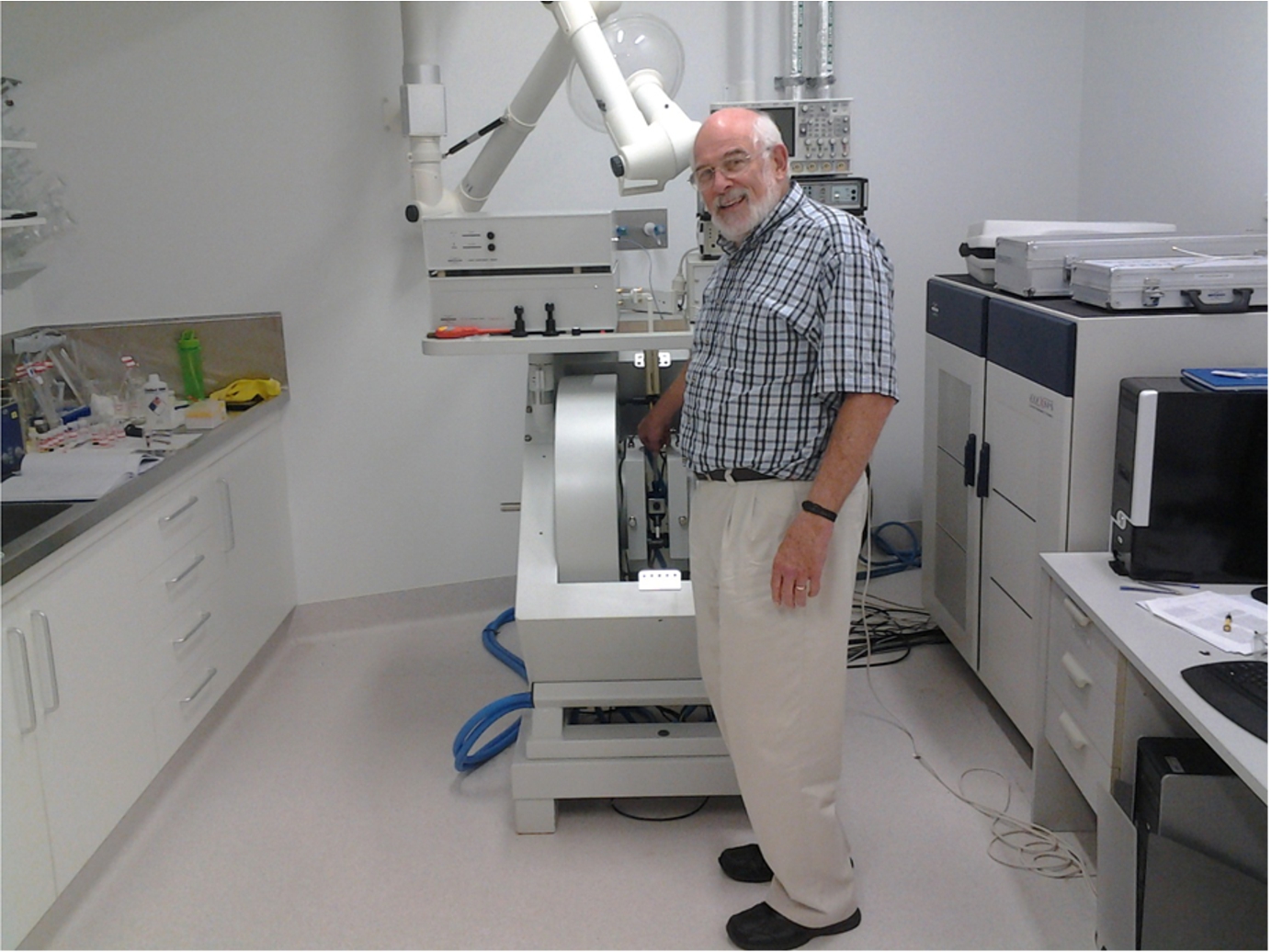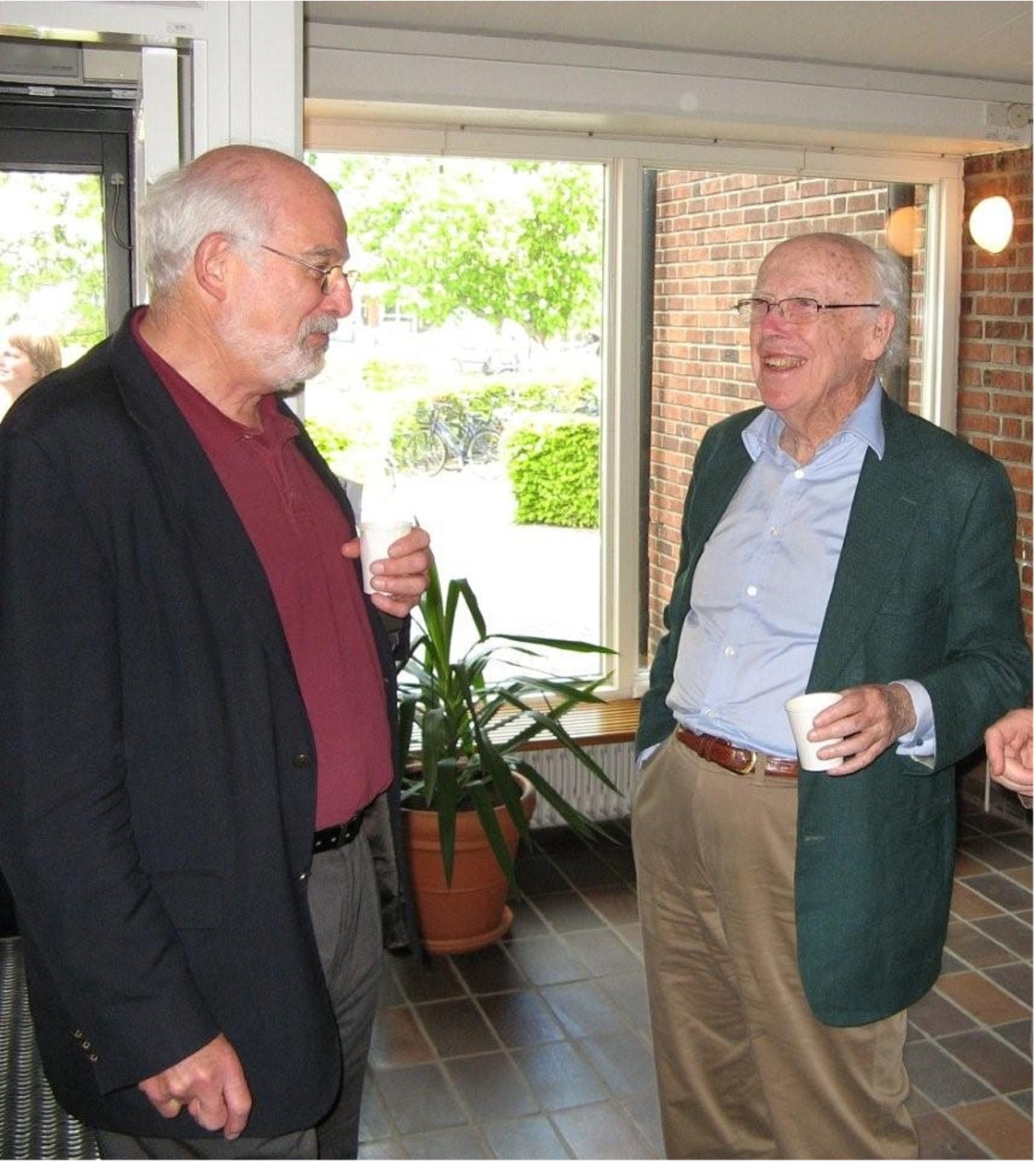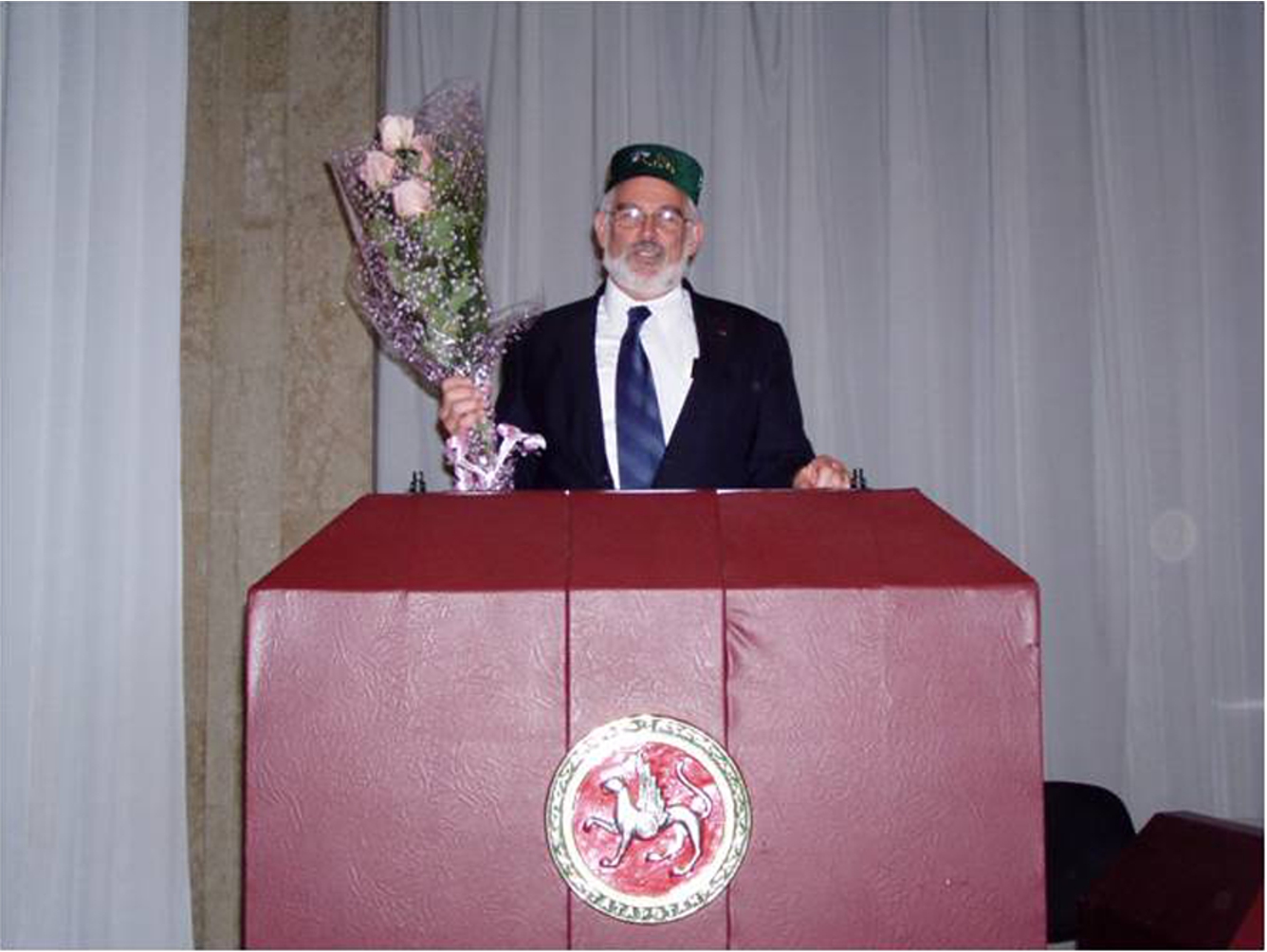Lawrence Berliner: Pioneer, educator and champion of biomedical EPR spectroscopy
Fig. 1.
Lawrence Berliner standing next to an EPR spectrometer at the Centre for Advanced Imaging, University of Queensland (Australia) where he had collaboration with the late Prof. Graeme Hanson who passed away in February 2015. Photograph provided by Lawrence Berliner.

Lawrence Berliner (see Figs 1–3) was born in 1941 in Los Angeles (California, USA). He completed his undergraduate studies in Chemistry at UCLA in 1963 and went on to complete his PhD in Chemistry at Stanford University in 1967. His PhD supervisor, the late Harden M. McConnel, is considered to be one of the leading physical chemists of the last half-century. Whilst Larry was a PhD student at Stanford, McConnel and his team first synthesised spin labels in 1965 [8] for use in the study of biological macromolecules using electron paramagnetic resonance (EPR) or electron spin resonance (ESR) spectroscopy. Larry was therefore closely involved in the development of EPR for biological studies from its early days. He moved to Oxford University (UK) in 1968 to pursue post-doctoral research in Biophysics with David C. Philips who was the first to determine the detailed atomic structure of the enzyme lysozyme [5]. During his stay in Oxford, Larry used X-ray crystallography to refine the structure of nitroxide spin label “2,2,6,6-tetramethyl-4-piperidinol-1-oxyl” [1]. He returned back to Stanford University to work with McConnel in 1969 and became an Assistant Professor of Chemistry at Ohio State University (OSU) in the same year. He was promoted to the position of Full Professor of Chemistry at OSU in 1982. In 2000, Larry moved to Denver where he served as the Professor and Chair of Chemistry at the University of Denver for many years. He is now an Emeritus Professor of Chemistry at the University of Denver and continues to be active in research involving application of EPR spectroscopy.
Fig. 2.
Lawrence Berliner (left) with James Watson who co-discovered the structure of DNA in 1953 with Francis Crick. Photograph provided by Lawrence Berliner.

Fig. 3.
Lawrence Berliner at the Zavoisky Award ceremony in Kazan, the capital of Tatarstan which sponsored the event. This annual Prize ceremony commemorates the contributions made by Yevgeny Zavoisky, from Kazan State University, who is regarded as the father of ESR. Photograph provided by Lawrence Berliner.

Larry had the privilege to be trained by two of the leading scientists, Harden M. McConnell and David C. Phillips, of the last half-century. This placed him in a strong position to carry out creative and innovative research of the highest quality for over four decades. Some of his pioneering work on the application of EPR spectroscopy was carried out at OSU. Larry is probably best known for his work on the development of a novel reversible thiol-specific spin label for site specific labelling of proteins [4]. This pioneering work formed the basis of Site Directed Spin Labeling (SDSL) which is very useful for studies of proteins that cannot be readily crystallised, especially membrane proteins. Another notable contribution by Larry has been the work he did with his colleague Hirotada Fujii (Tokyo Metropolitan Institute of Medical Science, Japan) on the feasibility and applications of in vivo ESR and EPR imaging to animal systems [3]. Thanks to the research effort by Larry and his colleagues in developing this approach, scientists around the world are able to study live animals by EPR spectroscopy.
Larry is a highly interdisciplinary and broad-minded scientist who is always prepared to explore different techniques and systems. Besides EPR he has employed a wide array of techniques in his research including X-ray crystallography, MRI, NMR, CD, fluorescence spectroscopy etc. He is currently investigating a family of calcium-binding proteins that possess anti-tumor properties in the molten globule form. This work involved collaboration with the late Graeme Hanson from the Centre for Advanced Imaging at the University of Queensland (see Fig. 1). Larry is also analysing free-radicals in-vivo in relation to major health problems including ischemia/heart disease.
The pioneering work of Larry in advancing biological EPR spectroscopy is widely recognised by the scientific community and he has received numerous awards for his contributions in the field. He served as the president of the International EPR society and is a fellow of the American Academy of Arts and Sciences and the American Chemical Society. Larry is a prolific writer and has published many scientific articles and books. Many graduate students and academics, from around the world, have benefited from his publications. His books have been valuable for researchers who are new to the field of EPR, as well as to established experts.
I first met Larry nearly 15 years ago at a UK biomedical spectroscopy conference which I was chairing. He presented a fascinating lecture at the conference that was well received by the audience. Larry has a friendly personality and I very much enjoyed his company discussing various topics. He took great interest in the work of other scientists, especially those in the early stage of their career. We maintained contact over the years, and when I asked him to write an article on the evolution of EPR spectroscopy, he readily agreed. Larry states in his article [2] that it is an honour for him to follow his two friends and colleagues, the late Iain D. Campbell [6] and Stanley J. Opella [7], in producing an article for this review series in Biomedical Spectroscopy and Imaging.
Larry has passionately championed EPR spectroscopy for over four decades through his research work, books and lectures at conferences and Universities around the globe. He has a truly international perspective to scientific research and has numerous friends and collaborators from many parts of the world. I very much hope that he continues to maintain his passion for scientific research and scholarly activity for many more years to come.
References
1 | [[1]] L.J. Berliner, Refinement and location of the hydrogen atoms in the nitroxide 2,2,6,6-tetramethyl-4-piperidinol-1-oxyl, Acta Crystallographica Section B: Structural Crystallography and Crystal Chemistry 26: ((1970) ), 1198–1202. |
2 | [[2]] L.J. Berliner, The evolution of biomedical EPR (ESR), Biomedical Spectroscopy and Imaging 5: ((2016) ), 5–26. |
3 | [[3]] L.J. Berliner and H. Fujii, Magnetic resonance imaging of biological specimens by electron paramagnetic resonance of nitroxide spin labels, Science 227: ((1985) ), 517–519. |
4 | [[4]] L.J. Berliner, J. Grunwald, H.O. Hankovszky and K. Hideg, A novel reversible thiol-specific spin label: Papain active site labeling and inhibition, Analytical Biochemistry 119: ((1982) ), 450–455. |
5 | [[5]] C.C. Blake, D.F. Koenig, G.A. Mair, A.C. North, D.C. Phillips and V.R. Sarma, Structure of hen egg-white lysozyme: A three-dimensional Fourier synthesis at 2 Angstrom resolution, Nature 206: ((1965) ), 757–761. |
6 | [[6]] I.D. Campbell, The evolution of protein NMR, Biomedical Spectroscopy and Imaging 2: ((2013) ), 245–264. |
7 | [[7]] S.J. Opella, The development of solid-state NMR of membrane proteins, Biomedical Spectroscopy and Imaging 3: ((2014) ), 81–105. |
8 | [[8]] T.J. Stone, T. Buckman, P.L. Nordio and H.M. McConnell, Spin-labeled biomolecules, Proceedings of the National Academy of Sciences of the United States of America 54: ((1965) ), 1010–1017. |




